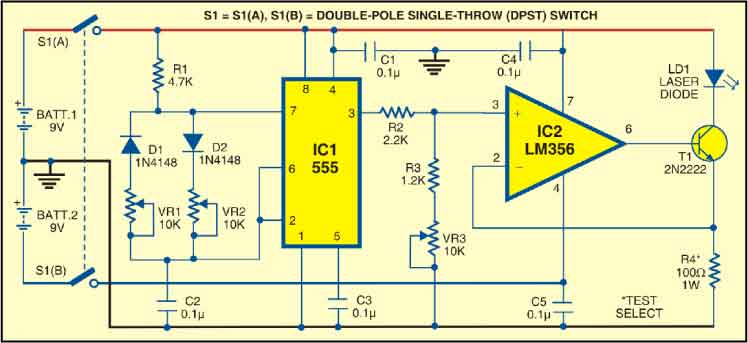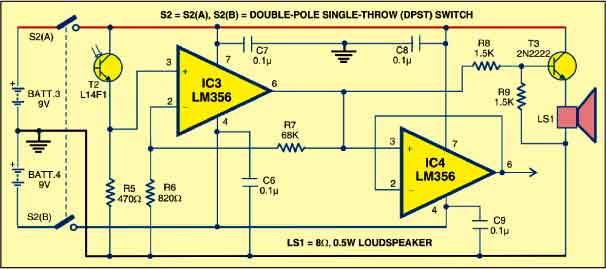Communicating with laser is not new. In this laser communication system, a laser beam is used as carrier, which is modulated by the signal to be transmitted. On the receiver end, the desired signal is separated from the carrier. A wireless laser link (through a laser diode) is used to transmit information from one end to another in its line of sight.
In this circuit, an electrical signal is transmitted from one place to another riding over the laser beam. If you vary some parameters of the transmitted signal (such as amplitude and frequency), the received signal changes accordingly.
Laser communication system
The entire circuit can be divided into two parts: transmitter and receiver.
The transmitter circuit is built around timer 555 (IC1). IC1 is wired as an astable multivibrator generating a pulse train at its pin 3 that serves as the modulation input for the laser diode. Set the frequency of this pulse train to around 1 kHz using presets VR1 and VR2.

The potential divider arrangement of resistors R2, R3 and pre-set VR3 is used to reduce the peak amplitude of the pulse train. The driver circuit for the laser diode is built around IC LM356 (IC2), transistor T1 and a few discrete components.
The transmitter circuit is powered by two 9V batteries that provide +9V, -9V and ground supplies. These voltages are provided to the transmitter circuit through DPST switch S1.

The receiver circuit (shown above) is built around IC3, IC4 and a few discrete components. The gain stage is built around IC LM356 (IC3) with gain value of (R6+R7)/R6. The output of IC3 drives a speaker through the emitter-follower arrangement configured around transistor T3. The unity-gain buffer stage built around IC4 facilitates viewing of the received signal on an oscilloscope if so desired.
The receiver circuit too is powered by two 9V batteries that provide +9V, -9V and ground supplies. These voltages are provided to the receiver circuit through DPST switch S2.
Circuit operation
Working of the circuit is simple. Align the transmitter and the receiver so that the laser light directly falls on the phototransistor. The speaker connected between the emitter of T3 and ground beeps to indicate that laser communication is taking place. You can change the pitch of the audio beep by changing the frequency of the transmitted signal through presets VR1 and VR2 in the transmitter.
Construction & testing
Assemble the transmitter and receiver circuits on separate general-purpose PCBs. Now adjust presets VR1 and VR2 to get approximately 1kHz pulse signal at pin 3 of IC1. Adjust preset VR3 to ensure that the desired current flows through the laser diode during the transmission.
The project was first published in May 2011 and has recently been updated.







Can we use 6v speaker. And how to connect oscilloscope.
What is the value of vr1 and vr2 to be set to make frequency 1khz at pin no. 3 and also where to connect audio input…
What is the value of vr3 to be adjusted?